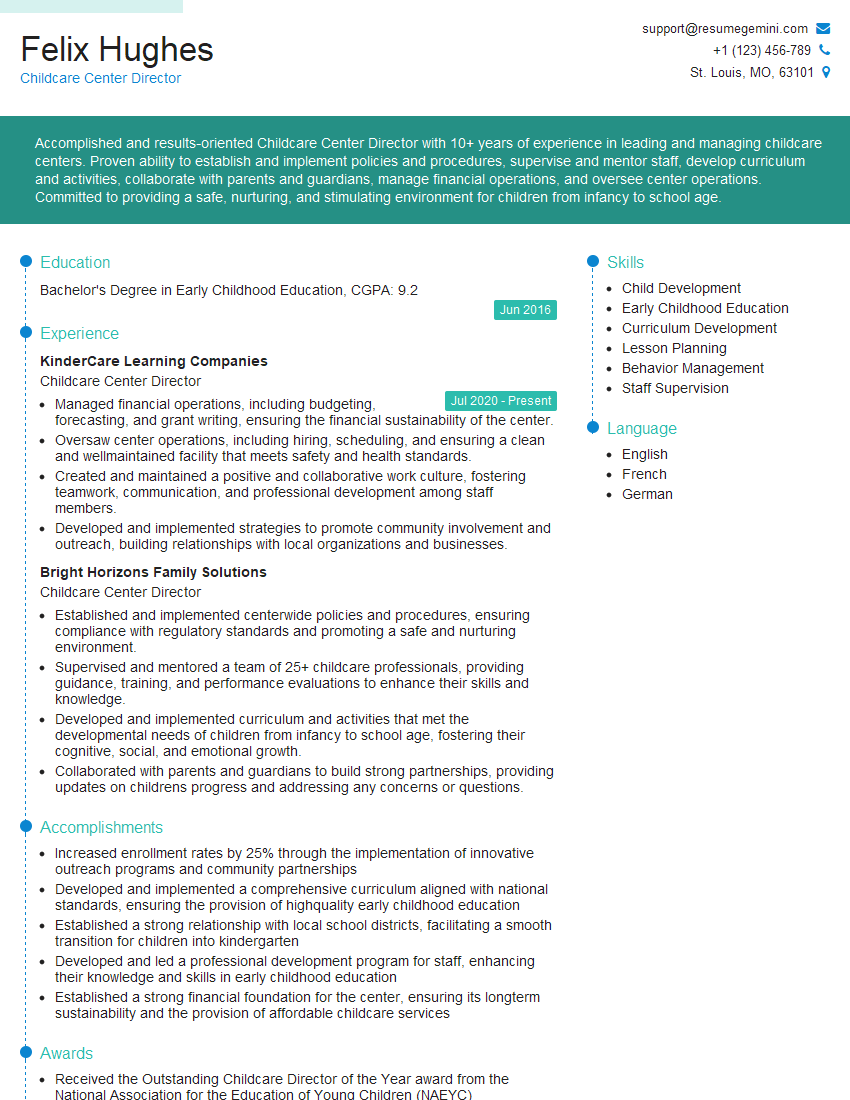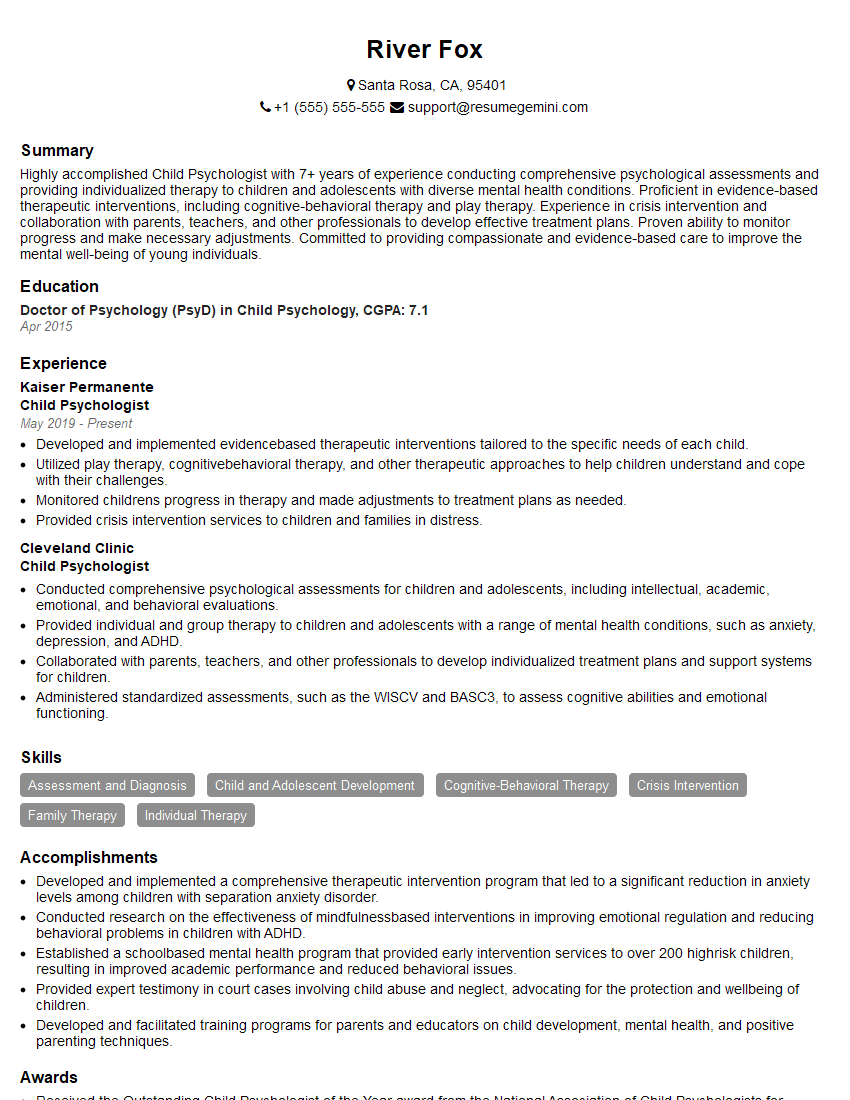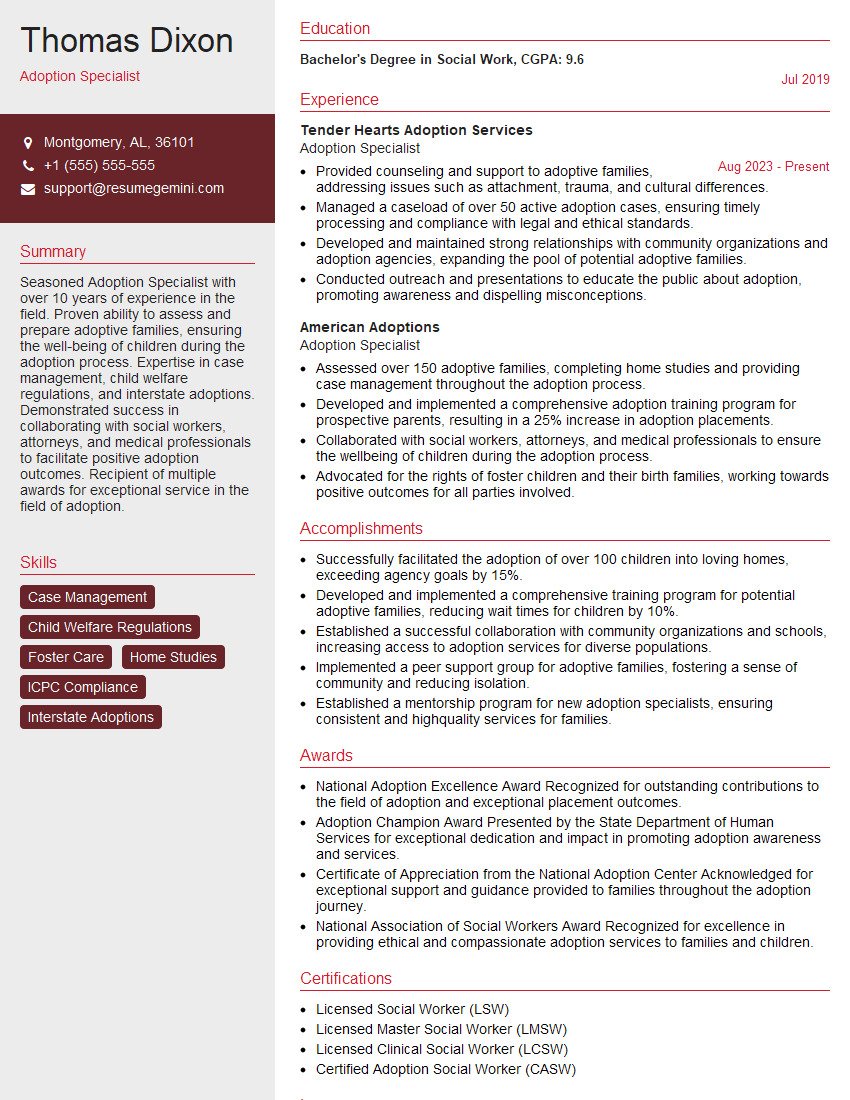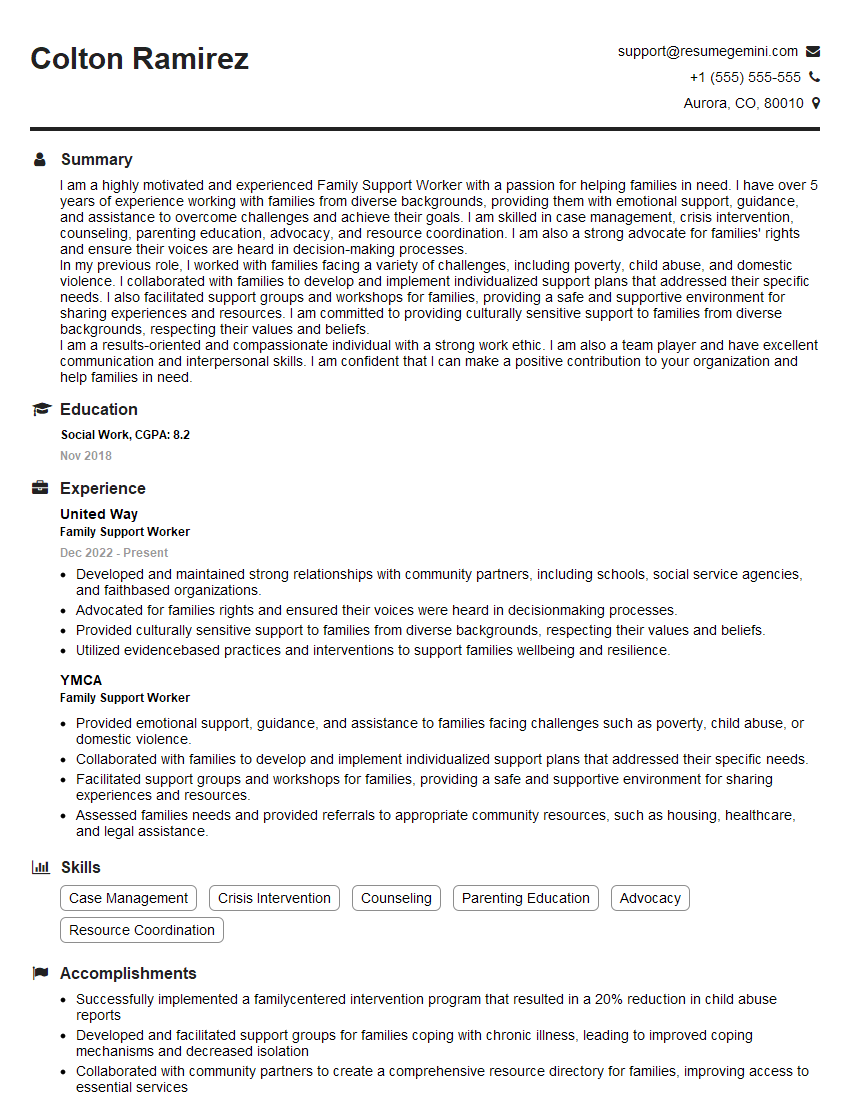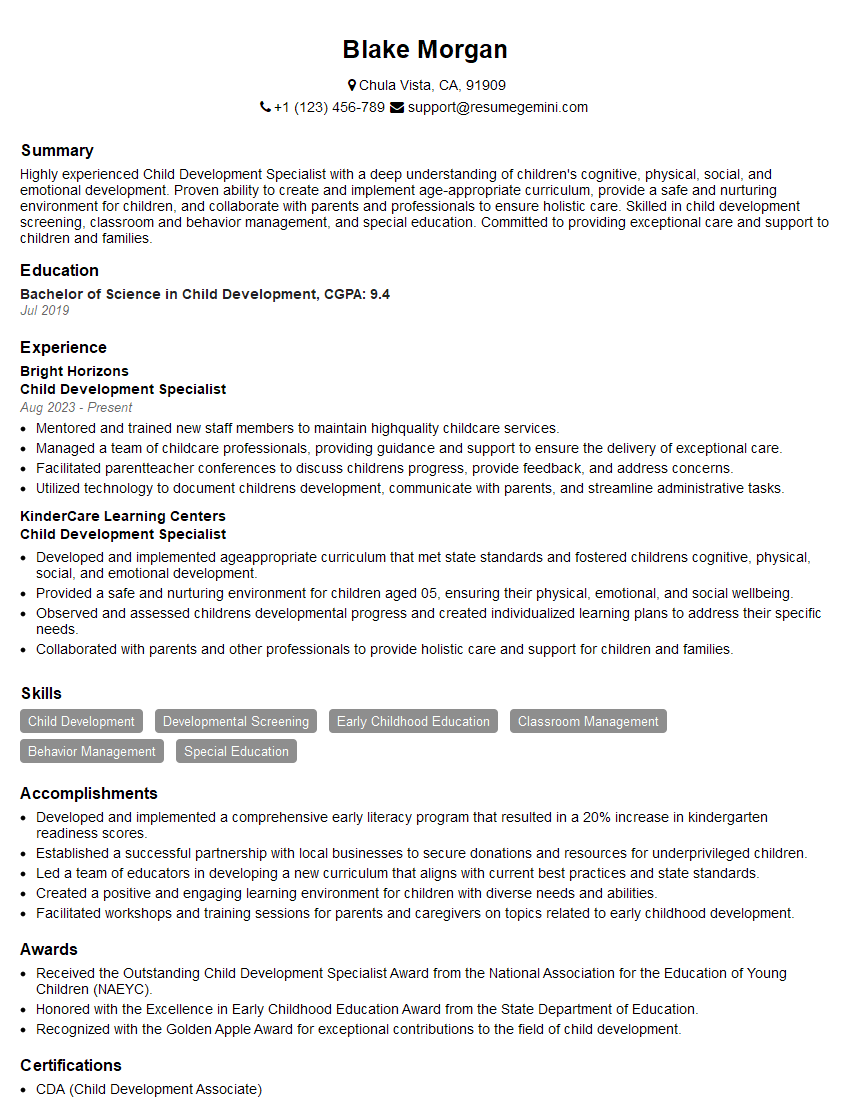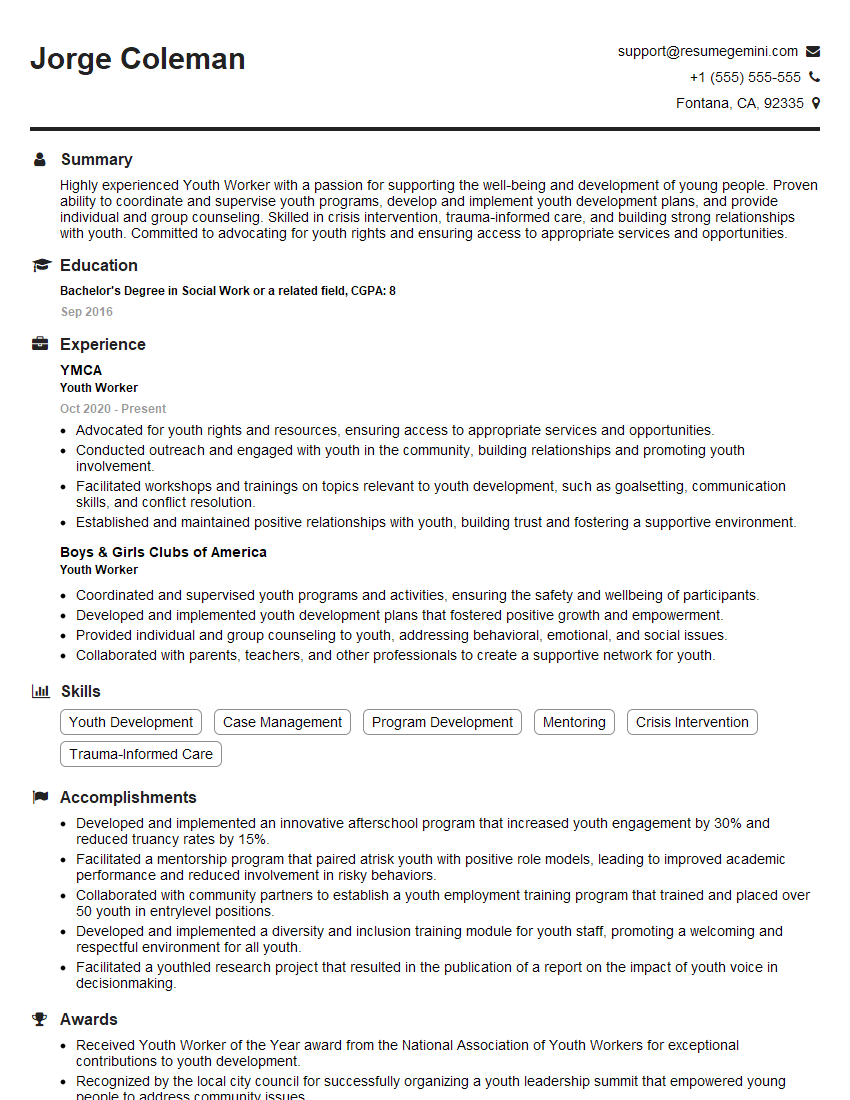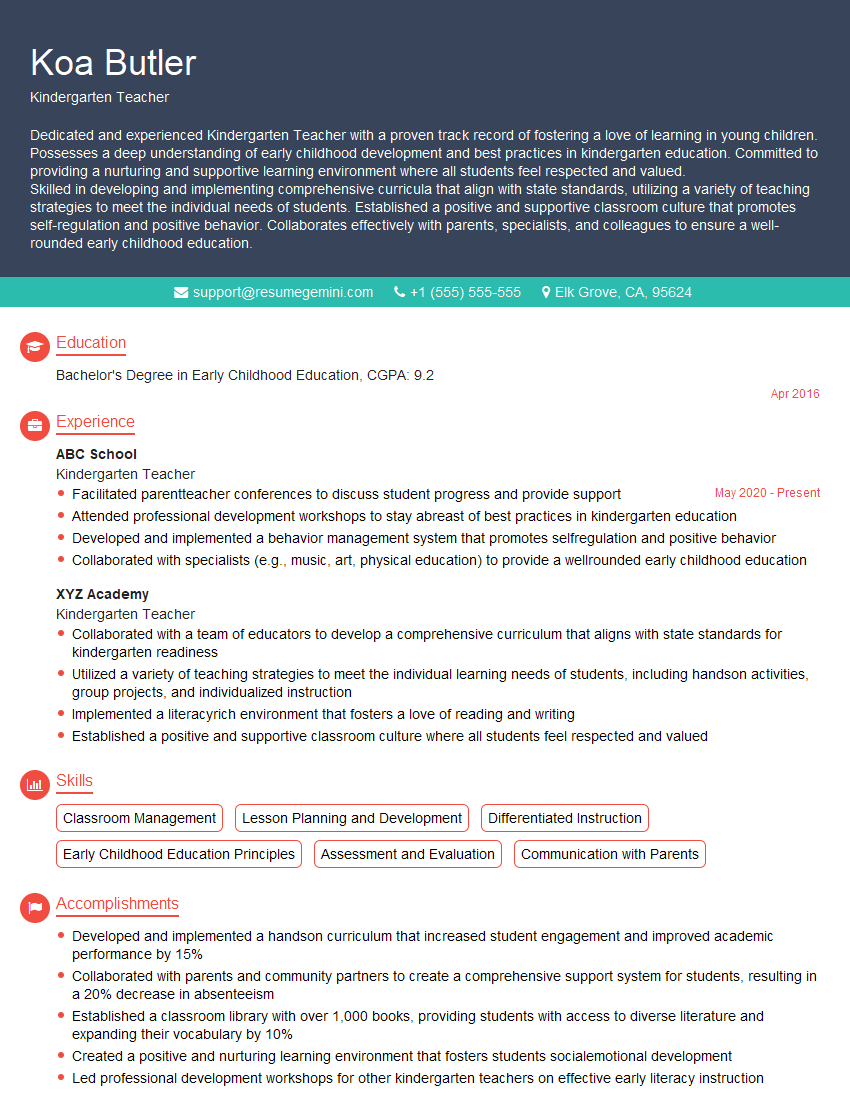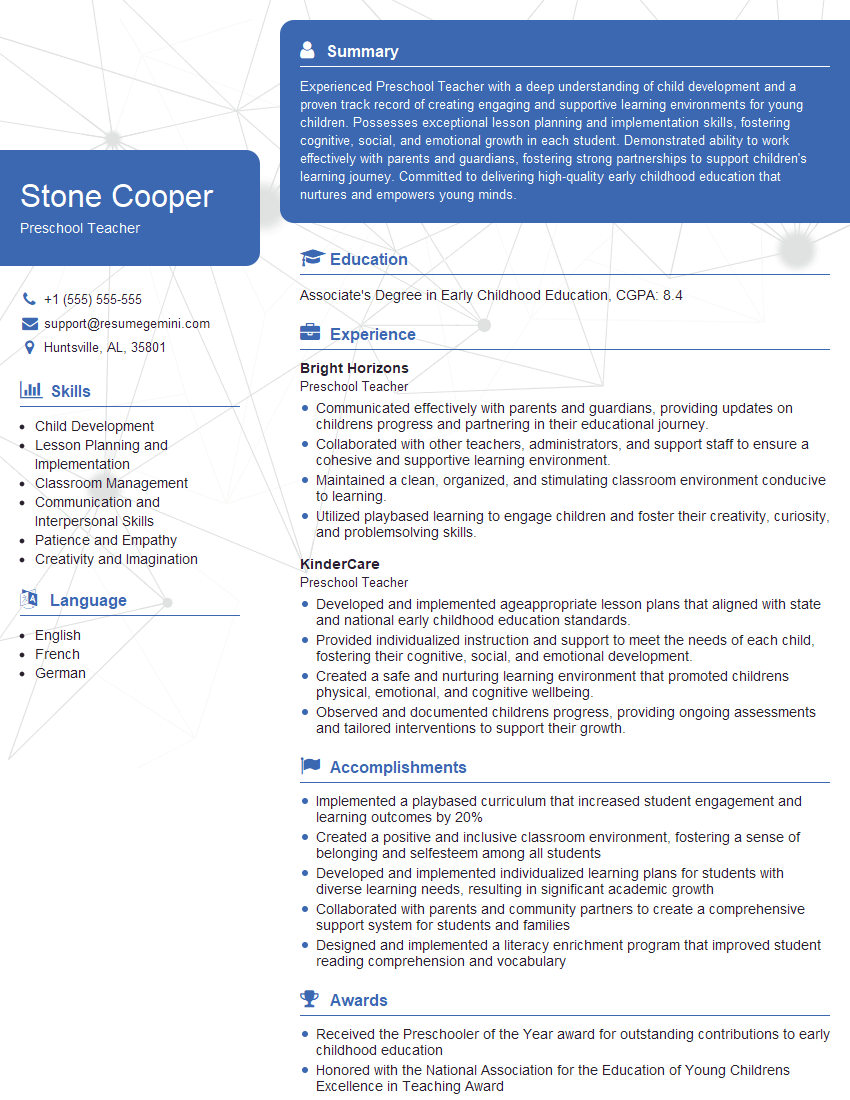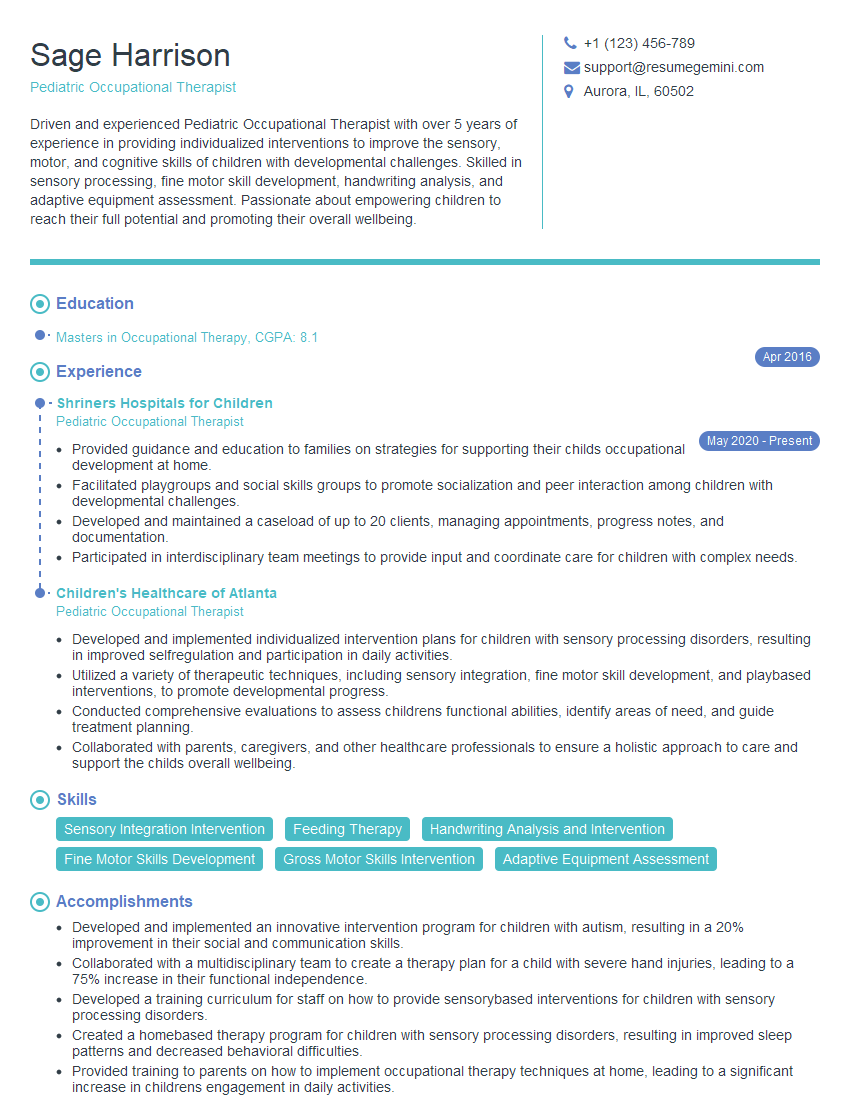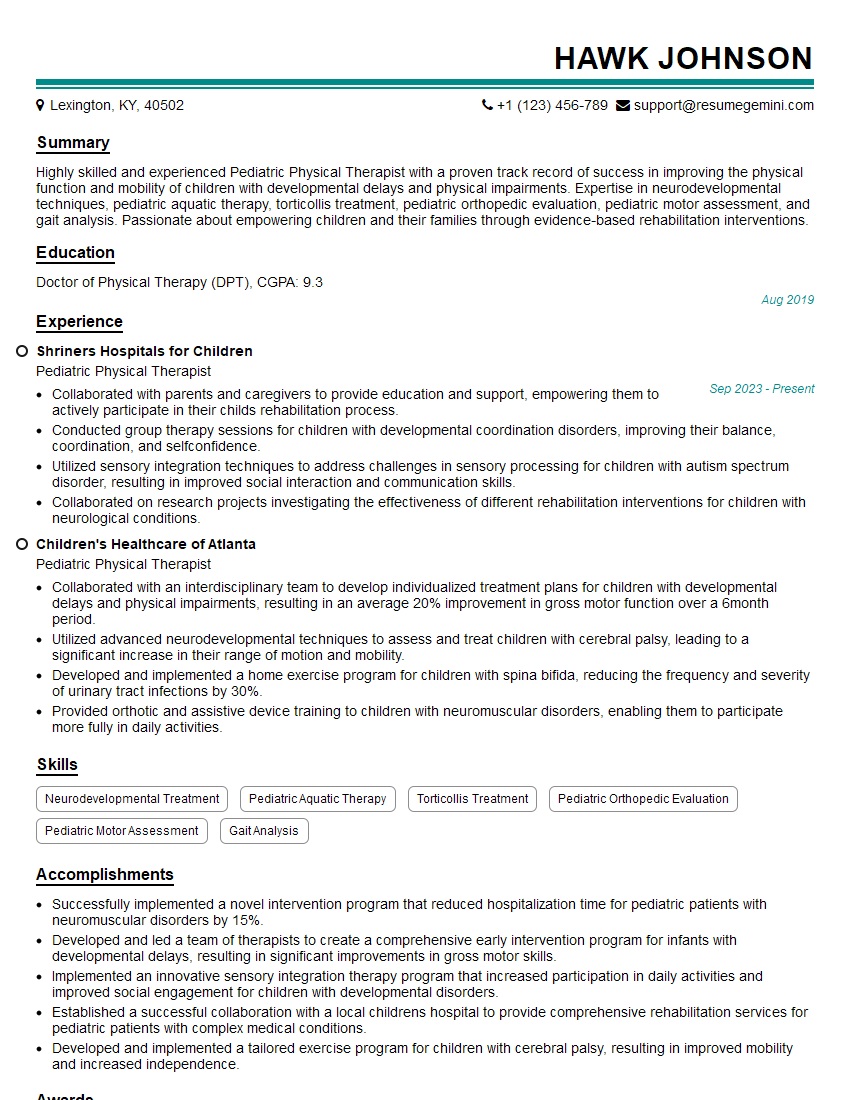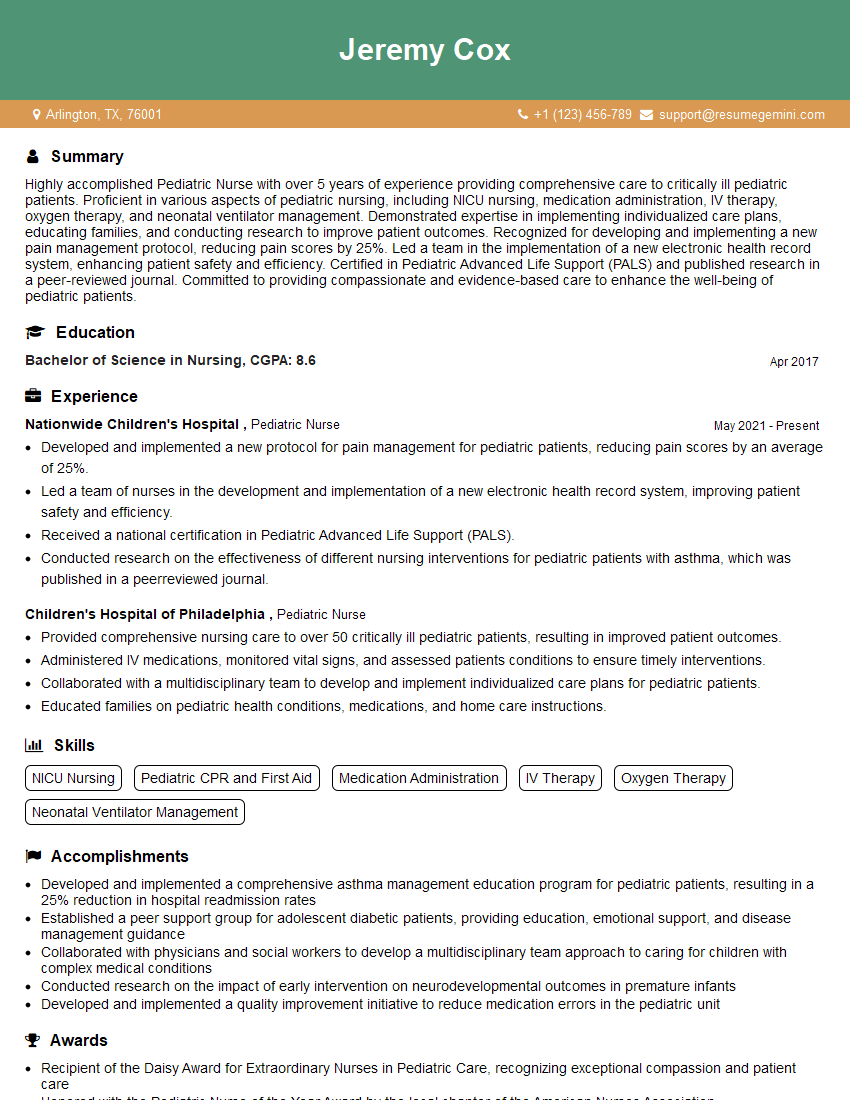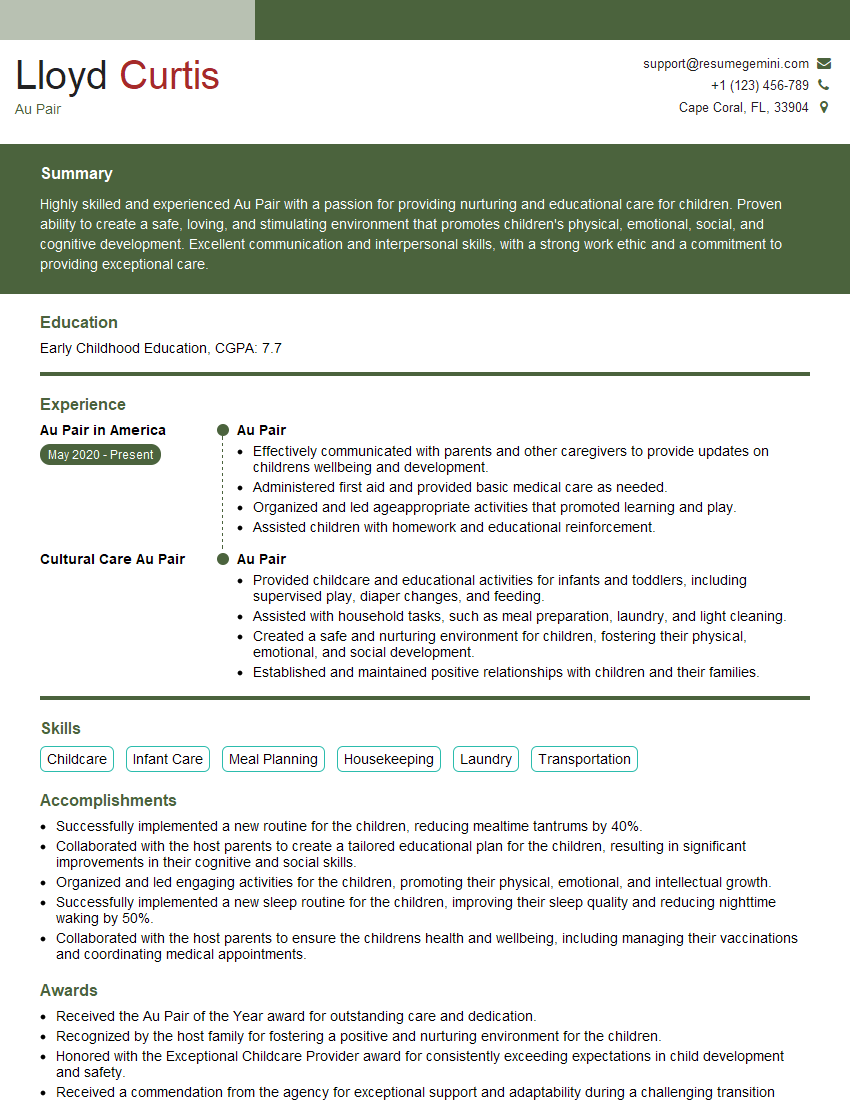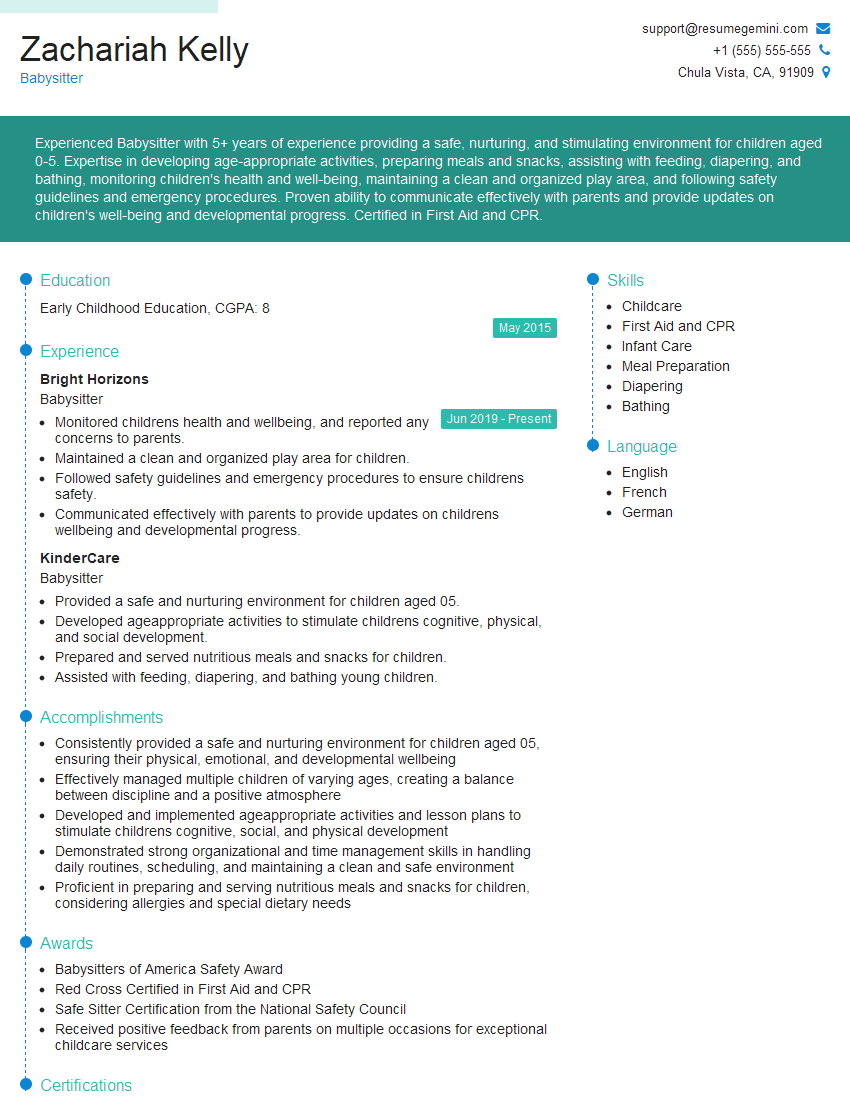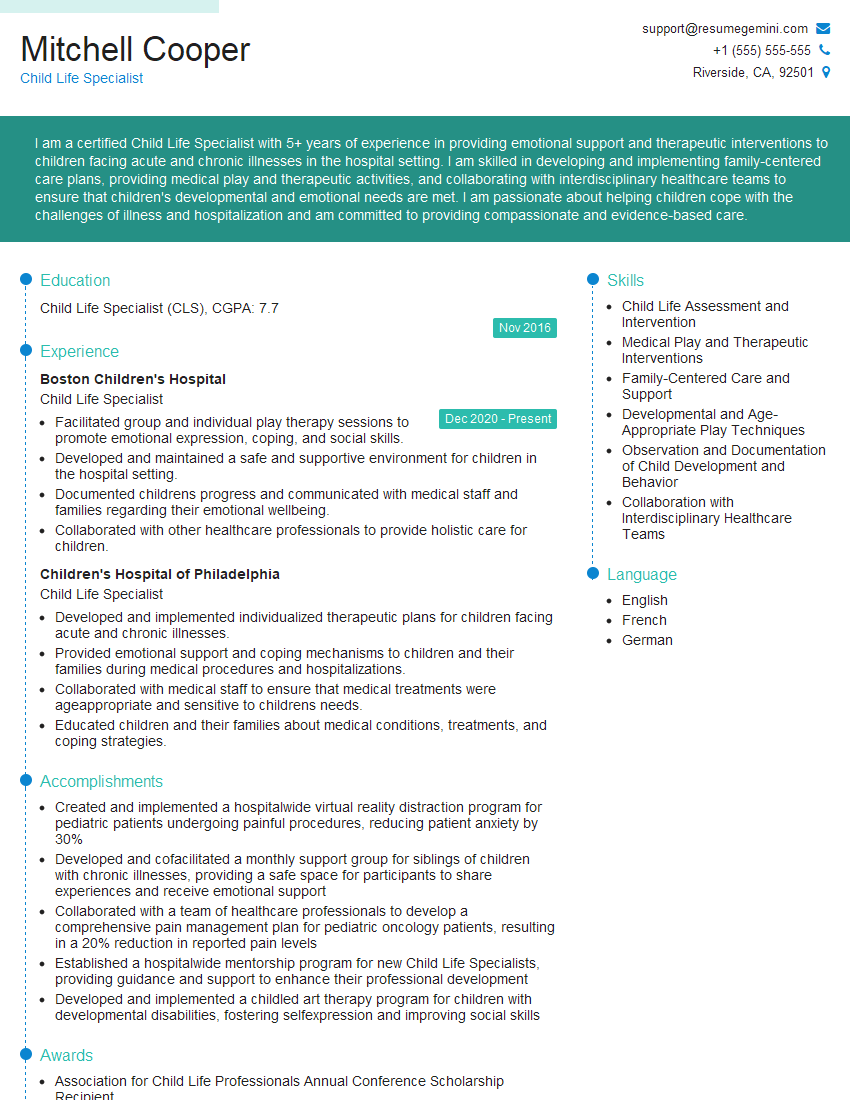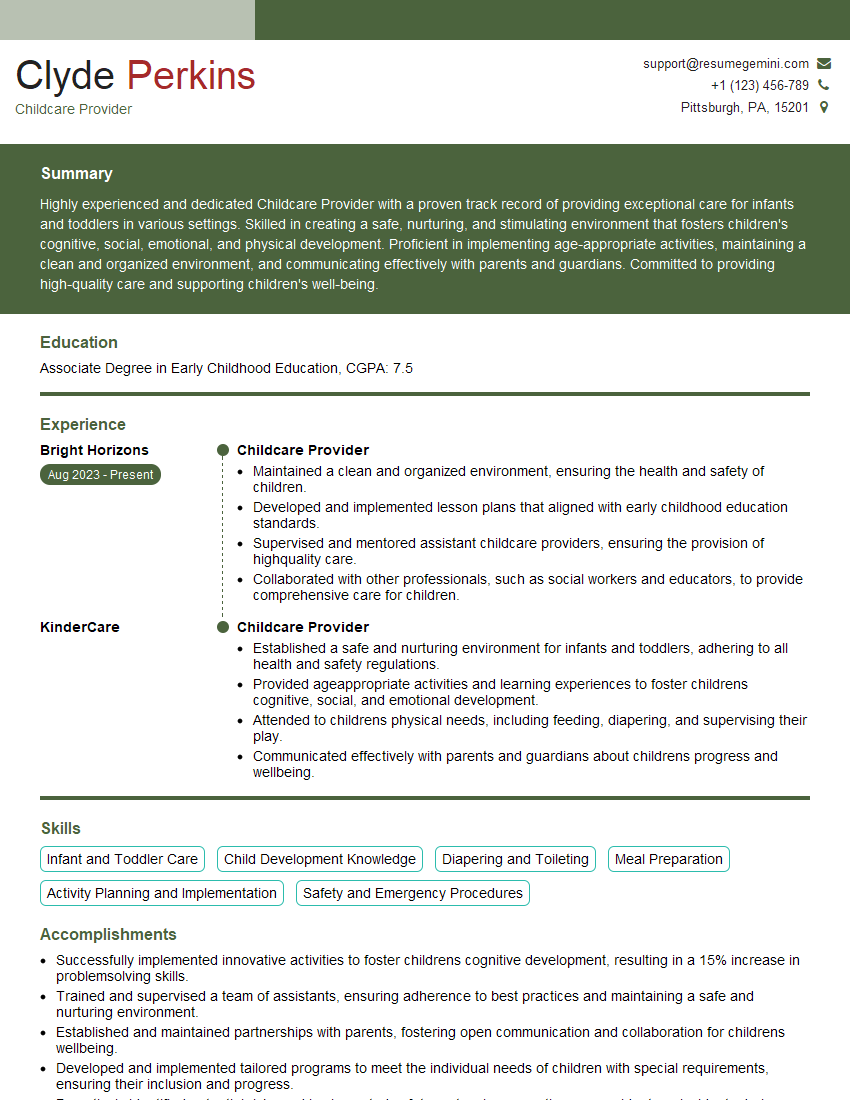Unlock your full potential by mastering the most common Working with Children interview questions. This blog offers a deep dive into the critical topics, ensuring you’re not only prepared to answer but to excel. With these insights, you’ll approach your interview with clarity and confidence.
Questions Asked in Working with Children Interview
Q 1. Describe your experience working with children of different age groups.
My experience spans working with children from infancy through adolescence. I’ve worked in various settings, including preschools, primary schools, after-school programs, and summer camps. Working with toddlers requires a focus on fostering their physical development, language acquisition, and social-emotional growth through play-based learning. For example, I implemented a sensory bin activity with toddlers to stimulate exploration and language development. With elementary-aged children, the focus shifts to academic skills, problem-solving, and building independence. I developed a creative writing project for this age group that encouraged collaboration and self-expression. Adolescents require a different approach, emphasizing critical thinking, social responsibility, and preparing them for future transitions. I supported teenagers in developing their leadership skills through group projects and community service initiatives.
Q 2. Explain your approach to classroom/care management.
My approach to classroom/care management is rooted in creating a structured yet flexible environment that balances routine with spontaneity. I believe in proactive management, establishing clear expectations and rules from the beginning, which are visually displayed and consistently reinforced positively. For example, I use a visual schedule with pictures to help younger children understand the daily routine. I utilize positive reinforcement techniques, rewarding good behavior with praise, incentives, and privileges. I foster a sense of community and belonging where children feel safe, respected, and supported. This might involve implementing a ‘buddy system’ to help younger children feel secure or creating class agreements collaboratively. Regular communication with parents and guardians is crucial to ensure consistent expectations and to address any arising concerns promptly.
Q 3. How do you handle challenging behaviors in children?
Handling challenging behaviors requires a calm, consistent, and empathetic approach. First, I aim to understand the root cause of the behavior. Is the child tired, hungry, frustrated, or feeling overwhelmed? I use positive behavior interventions and supports (PBIS), focusing on teaching appropriate behaviors rather than simply punishing inappropriate ones. For example, if a child is hitting, we would work together to identify alternative ways to express anger, such as taking deep breaths or using words. I establish clear consequences for misbehavior, which are communicated clearly and consistently enforced. For more severe or persistent issues, I collaborate closely with parents and specialists, such as school counselors or therapists, developing a comprehensive behavior management plan. It’s crucial to remember that each child is unique, and strategies need to be tailored accordingly.
Q 4. What strategies do you use to create a positive and supportive learning environment?
Creating a positive and supportive learning environment involves several key strategies. First, I prioritize establishing a warm and welcoming classroom where children feel safe and respected. This includes creating a visually appealing space, incorporating children’s artwork, and fostering a sense of community. Second, I encourage collaboration and peer interaction through group activities, cooperative games, and peer tutoring. I incorporate play-based learning, recognizing its crucial role in children’s development and making learning fun and engaging. Differentiated instruction is key; I adapt activities to cater to different learning styles and abilities. Positive reinforcement and encouragement are constantly utilized, celebrating successes and progress openly and authentically. Finally, regular positive communication with parents helps reinforce positive behavior and learning at home.
Q 5. Describe your experience with child development milestones.
My understanding of child development milestones is extensive, covering physical, cognitive, social-emotional, and language development across different age groups. I’m familiar with developmental screening tools and assessments used to track children’s progress. For example, I understand the importance of gross motor skill development in toddlers, such as walking and running, and how this progresses into more complex movements in older children. I know the typical stages of language acquisition, including babbling, first words, and sentence formation. I recognize the significance of social-emotional development, such as emotional regulation and empathy. This knowledge allows me to tailor activities and support to meet the specific needs of each child based on their individual developmental stage and to promptly identify any potential delays that might require further intervention.
Q 6. How do you adapt your teaching methods to meet the diverse learning needs of children?
Adapting teaching methods to meet diverse learning needs is paramount. I utilize differentiated instruction, which involves adjusting the content, process, product, or learning environment to meet individual needs. This might include providing varied learning materials, such as visual aids, manipulatives, and technology, to cater to diverse learning styles. For children with learning difficulties or disabilities, I implement individualized education programs (IEPs) or 504 plans, collaborating with specialists to provide tailored support. I incorporate various teaching strategies, such as storytelling, hands-on activities, games, and technology, to engage children with different learning preferences. Regular assessment allows me to monitor progress and adjust my teaching methods as needed to ensure all children are successful.
Q 7. How do you assess a child’s developmental progress?
Assessing a child’s developmental progress involves a multifaceted approach. I use a combination of formal and informal assessment methods. Formal assessments include standardized tests, developmental screenings, and progress reports, which provide objective data on a child’s skills and abilities. Informal assessments are equally important; these include observing children during play and activities, anecdotal records of behavior and interactions, and portfolios of children’s work. I also actively seek feedback from parents and collaborate with other professionals, such as speech therapists or occupational therapists, to gain a holistic understanding of the child’s development. The results of assessments inform my teaching practices, allowing me to plan appropriate interventions and adjust my teaching methods to support each child’s progress.
Q 8. Explain your understanding of child safety and well-being.
Child safety and well-being encompass a holistic approach to protecting children from harm and fostering their healthy development. It involves creating a secure and nurturing environment where children feel safe, respected, and valued. This includes physical safety, emotional well-being, and social development. It’s about preventative measures, like ensuring a hazard-free play area, and responsive measures, like knowing how to react to a child’s distress.
- Physical Safety: This includes preventing accidents through proper supervision, securing potentially dangerous items, and having appropriate safety equipment like first-aid kits and fire extinguishers readily available.
- Emotional Well-being: Creating a positive and supportive environment where children feel comfortable expressing their emotions, needs, and concerns without fear of judgment or punishment is crucial. This involves actively listening to children and validating their feelings.
- Social Development: Providing opportunities for children to interact with peers, learn social skills, and build healthy relationships fosters their social and emotional growth. This involves structured playtimes and opportunities for teamwork and collaboration.
For example, in my previous role, we implemented a strict ‘buddy system’ for outdoor activities, ensuring that every child had a partner to prevent wandering and mishaps. We also held regular safety drills to familiarise children with emergency procedures, making them feel secure and prepared.
Q 9. Describe your experience with developing and implementing lesson plans.
Developing and implementing lesson plans requires a deep understanding of child development, learning styles, and the curriculum. My approach involves a cyclical process of planning, implementing, assessing, and refining. I start by identifying the learning objectives, aligning them with the curriculum standards, and choosing age-appropriate activities.
- Planning: I carefully consider the children’s developmental stages, their interests, and any specific learning needs. This includes selecting engaging materials and activities that cater to different learning styles (visual, auditory, kinesthetic).
- Implementation: During the lesson, I observe children’s engagement and adapt the plan as needed, ensuring inclusivity and catering to individual learning paces. Flexibility is key!
- Assessment: I use various methods to assess children’s learning, including observation, informal assessments, and creative projects. This helps me understand their strengths and areas needing further support.
- Refinement: Based on my assessments, I refine the lesson plan for future use, ensuring continuous improvement and tailoring it to the children’s specific needs and responses.
For instance, when teaching about the solar system, I incorporated a hands-on activity where children created their own models using clay and paint, followed by a group discussion to consolidate their understanding. This multi-sensory approach proved highly effective.
Q 10. How do you communicate effectively with parents/guardians?
Effective communication with parents/guardians is essential for building trust and a strong partnership. I prioritize open, honest, and respectful communication, using multiple channels to keep them informed.
- Regular Updates: I provide regular updates on the child’s progress, both positive and areas needing attention, through newsletters, individual meetings, and informal conversations.
- Open Door Policy: I encourage parents to share concerns or suggestions at any time. Creating a welcoming and approachable atmosphere is crucial.
- Active Listening: I pay close attention to parents’ concerns and perspectives, actively listening and validating their feelings.
- Positive Language: I use positive language to frame my feedback, focusing on the child’s strengths and potential for growth.
For example, I initiated a weekly email newsletter to keep parents updated on classroom activities and their child’s progress, including photos and brief anecdotal observations. This helped foster a sense of community and transparency.
Q 11. How do you handle emergencies involving children?
Handling emergencies involving children requires quick thinking, decisive action, and a calm demeanor. A well-rehearsed emergency plan is crucial. My approach involves prioritizing the child’s safety and well-being while following established procedures.
- Immediate Action: Assess the situation and take immediate action to address the immediate threat, such as administering first aid or contacting emergency services.
- Child’s Needs: Prioritize the child’s physical and emotional needs, offering comfort and reassurance.
- Documentation: Thoroughly document the incident, including the time, location, actions taken, and any witnesses.
- Parent/Guardian Notification: Immediately notify the child’s parents/guardians about the incident and keep them updated on the child’s condition.
For example, during a minor playground accident, I immediately administered first aid, comforted the child, notified the parents, and documented the incident in the incident report log. Following our established procedure ensured a calm and efficient response.
Q 12. Describe your experience with inclusive practices in childcare.
Inclusive practices in childcare ensure that all children, regardless of their abilities, disabilities, or backgrounds, have equal opportunities to learn, grow, and thrive. It’s about creating a welcoming and supportive environment that celebrates diversity.
- Individualized Learning Plans: Developing individualized learning plans that cater to the unique needs and abilities of each child is fundamental. This involves working closely with specialists and parents.
- Accessible Environment: Ensuring the physical environment is accessible to all children, including those with mobility challenges, is essential. This includes ramps, adapted equipment, and clear pathways.
- Differentiated Instruction: Using differentiated instruction to adapt teaching methods and materials to suit the diverse learning styles and needs of children is vital. This might involve providing visual aids, using assistive technology, or offering different levels of support.
- Celebrating Diversity: Creating a classroom environment that embraces diversity and celebrates the unique cultures and backgrounds of all children promotes a sense of belonging and inclusion.
In a previous setting, we adapted our play equipment to accommodate children with physical limitations, created visual schedules to support children with autism, and incorporated diverse literature and cultural activities into our curriculum. These strategies promoted a genuinely inclusive learning environment.
Q 13. What is your understanding of child abuse and neglect?
Child abuse and neglect encompass a range of acts that harm a child’s physical, emotional, or psychological well-being. Abuse can be physical, emotional, sexual, or neglectful. Neglect involves the failure to provide basic needs such as food, shelter, clothing, medical care, or supervision.
- Physical Abuse: Intentional infliction of physical injury or harm.
- Emotional Abuse: Verbal abuse, threats, humiliation, or rejection that harms the child’s self-esteem and emotional development.
- Sexual Abuse: Any sexual act, exploitation, or contact with a child.
- Neglect: Failure to provide adequate care, leading to physical or emotional harm.
Understanding the signs and indicators of abuse and neglect is paramount for early intervention and protection. These signs can be physical, behavioral, or emotional, and vary significantly depending on the type of abuse or neglect.
Q 14. How would you respond to suspected child abuse?
Responding to suspected child abuse requires immediate action and adherence to mandatory reporting laws. My approach is guided by a combination of professional judgment, ethical considerations, and legal requirements.
- Document Observations: Carefully document all observations and interactions related to the suspected abuse, including dates, times, specific behaviors, and any statements made by the child or others.
- Report Suspicions: Report suspicions immediately to the appropriate authorities, such as child protective services or the police. This is a legal and ethical obligation.
- Child’s Safety: Prioritize the child’s safety and well-being. This may involve taking steps to protect the child from further harm, while maintaining appropriate professional boundaries.
- Collaboration with Authorities: Fully cooperate with the authorities’ investigation and provide all relevant information.
Remember, it’s better to err on the side of caution. If you have any concerns about a child’s safety, it’s crucial to report your suspicions to the relevant authorities. Your intervention could save a child’s life.
Q 15. What strategies do you use to foster children’s social-emotional development?
Fostering children’s social-emotional development is crucial for their overall well-being and future success. My strategies are multifaceted and focus on building a secure and nurturing environment where children feel safe to explore their emotions and interact with others.
Creating a Safe Space: I establish a classroom environment that’s predictable, consistent, and filled with warmth. This includes clear routines, consistent expectations, and plenty of opportunities for children to express themselves without judgment. For example, having a designated ‘calm-down corner’ with soft cushions and books allows children to self-regulate when feeling overwhelmed.
Emotional Literacy: I explicitly teach children about different emotions, helping them name and understand their feelings and those of others. We use picture books, role-playing, and discussions to explore a wide range of emotions, from happiness and sadness to anger and frustration. For example, we might read a story about a character feeling jealous and discuss healthy ways to manage that emotion.
Social Skills Development: I facilitate opportunities for children to practice essential social skills like sharing, cooperation, empathy, and conflict resolution. This includes structured activities like group games, collaborative projects, and conflict mediation. For example, I might guide children through a disagreement about a toy by helping them brainstorm solutions together.
Positive Reinforcement: I focus on praising positive behaviors and effort rather than solely focusing on correcting negative ones. Positive reinforcement fosters self-esteem and encourages children to repeat desired behaviors. For example, I might praise a child for sharing their crayons with a friend or for trying their best on a difficult task.
Career Expert Tips:
- Ace those interviews! Prepare effectively by reviewing the Top 50 Most Common Interview Questions on ResumeGemini.
- Navigate your job search with confidence! Explore a wide range of Career Tips on ResumeGemini. Learn about common challenges and recommendations to overcome them.
- Craft the perfect resume! Master the Art of Resume Writing with ResumeGemini’s guide. Showcase your unique qualifications and achievements effectively.
- Don’t miss out on holiday savings! Build your dream resume with ResumeGemini’s ATS optimized templates.
Q 16. Describe your experience working with children with special needs.
I have extensive experience working with children with diverse needs, including those with autism spectrum disorder, ADHD, learning disabilities, and speech impairments. My approach is always individualized and based on a thorough understanding of each child’s unique strengths and challenges. I collaborate closely with therapists, special educators, and parents to develop and implement individualized education programs (IEPs) or individualized support plans.
For instance, I worked with a child diagnosed with autism who struggled with social interaction. I implemented strategies like visual schedules, social stories, and structured play activities to help him understand expectations and improve his communication skills. I also focused on building his self-esteem by celebrating his achievements, no matter how small.
My experience has taught me the importance of patience, flexibility, and creativity in adapting my teaching methods to meet each child’s individual needs. It’s about creating a supportive and inclusive environment where every child can thrive.
Q 17. How do you manage your time effectively when working with multiple children?
Managing my time effectively when working with multiple children requires careful planning and organization. I utilize several strategies to ensure that all children receive the attention and support they need.
Structured Schedule: I create a daily schedule that incorporates various activities, including free play, structured learning, and transitions. This predictable routine helps children understand expectations and minimizes disruptions.
Prioritization: I prioritize tasks based on urgency and importance, focusing on activities that best meet the children’s immediate needs. For example, attending to a child’s immediate distress takes precedence over a planned craft activity.
Differentiated Instruction: I adapt my teaching methods to suit the different developmental levels and learning styles of each child. This allows me to address the needs of all children simultaneously, even during group activities.
Delegation (if applicable): In team settings, I collaborate with colleagues and delegate tasks to ensure efficient use of time and resources. This could involve sharing responsibilities for supervision, preparing materials, or addressing individual needs.
Time Management Tools: I use visual aids, timers, and checklists to manage transitions and stay on track. This helps children understand time constraints and promotes a sense of predictability.
Q 18. How do you maintain a positive attitude and enthusiasm when working with children?
Maintaining a positive attitude and enthusiasm is essential in working with children. It creates a nurturing environment where children feel safe, valued, and motivated to learn and grow. Here’s how I do it:
Passion for the Work: My genuine love for children and education fuels my enthusiasm. I find immense joy in witnessing their growth and development.
Self-Care: Prioritizing my own well-being is crucial. This includes getting enough sleep, exercising regularly, and engaging in activities that bring me joy and relaxation outside of work. A well-rested and balanced caregiver is better equipped to handle the demands of the job.
Mindfulness and Reflection: I take time to reflect on my interactions with children, celebrating successes and learning from challenges. This helps maintain a positive perspective and prevents burnout.
Connecting with Children: I build strong relationships with children by actively listening to them, showing genuine interest in their lives, and creating opportunities for positive interaction. This creates a reciprocal relationship based on trust and respect.
Celebrating Successes: I actively celebrate both big and small achievements with children, fostering a sense of accomplishment and reinforcing positive behaviors.
Q 19. Explain your understanding of child psychology.
My understanding of child psychology is rooted in developmental theories, focusing on the biological, cognitive, social, and emotional aspects of a child’s growth. I understand that children develop at different paces, influenced by genetics, environment, and individual experiences. Key concepts I apply include:
Developmental Stages: I’m familiar with various developmental milestones across different domains (physical, cognitive, social-emotional, and language) and understand how these stages influence a child’s behavior and learning.
Attachment Theory: I recognize the importance of secure attachment relationships between children and caregivers in shaping a child’s emotional well-being and social development. This informs how I interact with the children and support their relationships with their parents or guardians.
Cognitive Development: I understand how children’s thinking and reasoning abilities evolve over time, from concrete to abstract thought. This informs my teaching strategies and allows me to provide developmentally appropriate activities.
Social-Emotional Learning: I understand the significance of emotional intelligence and social skills in a child’s overall development, and how these skills impact their ability to form relationships and navigate social situations.
Individual Differences: I recognize that every child is unique and has their own learning style, temperament, and developmental trajectory. This guides my approach to individualized learning and support.
Q 20. How do you ensure a safe and healthy environment for children?
Ensuring a safe and healthy environment is my top priority. My strategies include:
Safety Protocols: I rigorously adhere to all safety regulations and protocols, including those related to hygiene, emergency procedures, and supervision. This includes regular safety checks of the environment and equipment.
Hygiene Practices: I emphasize regular handwashing, proper food handling, and cleaning procedures to prevent the spread of illness. This includes teaching children about good hygiene practices.
Supervision: I provide constant and attentive supervision to prevent accidents and injuries. The level of supervision is adjusted to the age and developmental needs of the children.
Risk Management: I proactively identify and mitigate potential hazards, ensuring the play area is free from dangerous objects and that activities are age-appropriate and supervised.
First Aid and Emergency Procedures: I am trained in basic first aid and CPR and am familiar with emergency procedures in case of accidents or illnesses.
Child Protection Policies: I am knowledgeable about and strictly adhere to all child protection policies and procedures, reporting any concerns immediately to the appropriate authorities.
Q 21. Describe your experience with different child care philosophies (e.g., Montessori, Reggio Emilia).
I have experience working within several child care philosophies, including Montessori and Reggio Emilia. These approaches differ in their emphasis but share a common goal: to create a stimulating and child-centered learning environment.
Montessori: This approach emphasizes self-directed activity, hands-on learning, and collaborative play. Children choose their activities from a range of specially designed materials that encourage exploration and discovery. I’ve found this method incredibly effective in fostering independence and problem-solving skills in children.
Reggio Emilia: This approach emphasizes the child’s potential and the role of the environment in shaping their learning. It encourages creativity, collaboration, and project-based learning, often using art and design as tools for exploration and expression. I have incorporated Reggio Emilia principles by creating open-ended projects that encourage children’s imagination and allow for multiple interpretations and solutions.
Other Approaches: I also have experience with other approaches such as play-based learning, which focuses on the importance of unstructured play in child development, and project-based learning, which fosters problem-solving and critical thinking through hands-on, real-world projects.
My experience working within these various philosophies has broadened my understanding of effective teaching methodologies and allows me to adapt my practice to suit the individual needs and learning styles of the children in my care. I believe a balanced approach, drawing on the strengths of different philosophies, is most beneficial for children’s holistic development.
Q 22. How do you promote creativity and imagination in children?
Promoting creativity and imagination in children involves fostering a safe and stimulating environment where they feel free to explore, experiment, and express themselves without judgment. This isn’t just about art supplies; it’s about the entire learning experience.
Open-ended activities: Instead of structured coloring pages, provide loose materials like crayons, paints, and clay, allowing children to create freely. For example, a simple prompt like ‘build a world’ with blocks can lead to incredibly imaginative constructions.
Storytelling and role-playing: Encourage imaginative play through storytelling, puppet shows, or dramatic play. Providing props like costumes or simple sets can greatly enhance this. Imagine the possibilities when children create their own plays using household items!
Nature exploration: Trips to parks or nature centers offer boundless opportunities for imaginative play. Children can invent stories about the creatures they encounter or build imaginary worlds using natural materials.
Music and movement: Music and dance are fantastic outlets for creative expression. Let children create their own dances or compose simple songs. The freedom to explore sounds and rhythms sparks their imaginations.
Providing a safe space for risk-taking: Encourage children to try new things, even if they make mistakes. This fosters resilience and allows them to learn from their experiences, leading to more creative exploration in the future.
Q 23. What strategies do you use to encourage children’s independence?
Encouraging independence in children is a gradual process that involves providing age-appropriate challenges and supporting their efforts. It’s about building their confidence and self-reliance, not simply leaving them to fend for themselves.
Age-appropriate choices: Offer children choices within a defined set of options. For example, ‘Would you like to wear the red shirt or the blue shirt?’ This fosters a sense of control.
Problem-solving opportunities: Encourage children to find solutions to minor problems independently. For instance, if a block tower falls, guide them to rebuild it rather than immediately fixing it for them.
Self-care skills: Teach children self-care skills like dressing themselves, brushing their teeth, and tidying up their belongings. Break down tasks into smaller, manageable steps and provide positive reinforcement.
Positive reinforcement: Celebrate their achievements and efforts, focusing on their progress rather than perfection. Words of encouragement like ‘You did a great job trying!’ are far more effective than criticism.
Gradual increase in responsibility: As children develop, gradually increase the level of independence expected of them. Start with small tasks and then move to more complex ones.
Q 24. Describe a time you had to resolve a conflict between children.
I once had a disagreement between two children over a toy. Both were adamant they deserved it. Instead of immediately intervening, I first allowed them to express their feelings. I used active listening, repeating back what each child said to ensure they felt heard. Then I guided them towards a solution using a collaborative approach. We brainstormed options together; they decided to share the toy for a set time, taking turns. This taught them negotiation skills and conflict resolution. The key was creating a safe space where they could express their emotions and collaboratively find a solution. This experience highlighted the importance of patience, active listening, and empowering children to solve their disputes. It is important to remember that fairness doesn’t always mean equality; it means that each child feels understood and fairly treated within the limits of the situation.
Q 25. How do you build rapport with children?
Building rapport with children involves creating a trusting and respectful relationship based on genuine connection and empathy. It’s about showing that you care and understand them as individuals.
Active listening: Truly listen to what children have to say, paying attention to both their verbal and nonverbal cues. Show them that you value their perspectives.
Respectful communication: Talk to children at their eye level, using language they understand. Avoid talking down to them or using patronizing tones.
Shared activities: Engage in activities that children enjoy. This could involve playing games, reading books, or participating in creative projects together. Shared laughter is a powerful bonding tool.
Positive body language: Smile, make eye contact, and use open and welcoming body language. These nonverbal cues convey warmth and approachability.
Showing genuine interest: Ask open-ended questions to learn about their interests and experiences. Show a genuine curiosity in their lives.
Q 26. How do you incorporate play-based learning into your curriculum?
Play-based learning is the cornerstone of my curriculum. It’s not just about playtime; it’s a structured approach to learning through engaging, hands-on activities. I carefully select activities to align with learning objectives, using play as a vehicle for skill development.
Dramatic play: Role-playing scenarios can teach social skills, problem-solving, and language development. For example, a pretend grocery store can reinforce math skills (counting money) and literacy (reading labels).
Construction play: Building blocks, LEGOs, and other construction toys encourage spatial reasoning, problem-solving, and fine motor skills. This also fosters creativity and collaboration.
Arts and crafts: Art projects allow for self-expression, creativity, and fine motor development. They can also be integrated with other learning areas, such as science (exploring textures) or history (creating art inspired by different cultures).
Outdoor play: Nature-based play fosters physical activity, creativity, and exploration. It also enhances children’s understanding of the natural world.
Games: Board games, card games, and other games develop cognitive skills, social skills, and problem-solving abilities. Games are also a fantastic way to incorporate math or literacy skills in a low-pressure, fun way.
Q 27. What professional development activities have you undertaken to improve your skills?
I am committed to continuous professional development. Recently, I completed a course on trauma-informed practices in early childhood education. This training equipped me with the knowledge and skills to create a supportive and understanding environment for children who may have experienced adverse childhood experiences. I also regularly attend workshops and conferences focusing on best practices in early childhood education, including sessions on inclusive education and child development. I actively seek out opportunities to learn and grow, ensuring I stay updated on current research and best practices in the field.
Q 28. How do you maintain confidentiality in your work with children?
Maintaining confidentiality is paramount in my work with children. I adhere strictly to all relevant regulations and guidelines concerning child protection. I only share information with authorized personnel and only when necessary for the child’s well-being or safety. I understand the importance of protecting a child’s privacy and I ensure all discussions are kept within appropriate and confidential settings, following strict organizational protocols.
Limited sharing: I only share information with those directly involved in the child’s care, such as parents, teachers, or relevant professionals, and only with their explicit consent whenever possible.
Secure storage: I store all sensitive information securely and according to organizational policies. This includes electronic and physical records.
Professional boundaries: I maintain professional boundaries, avoiding casual conversations about children outside of the professional setting.
Reporting procedures: I am fully aware of, and trained in, appropriate procedures for reporting any concerns about a child’s safety or well-being. This includes mandatory reporting regulations.
Key Topics to Learn for Working with Children Interview
- Child Development Theories: Understanding key developmental stages (e.g., Piaget, Erikson) and their implications for child interaction and care.
- Child Safety and Well-being: Practical application of safety procedures, recognizing signs of abuse or neglect, and implementing appropriate responses.
- Effective Communication with Children: Techniques for building rapport, active listening, and adapting communication styles to different age groups and abilities.
- Legal and Ethical Considerations: Familiarity with relevant legislation, mandatory reporting requirements, and maintaining professional boundaries.
- Classroom Management and Discipline: Strategies for positive behavior management, conflict resolution, and creating a supportive learning environment.
- Inclusive Practices: Understanding the needs of children with diverse backgrounds, learning styles, and abilities, and implementing inclusive practices.
- Working with Families: Effective communication and collaboration with parents/guardians to support the child’s development and well-being.
- Problem-Solving and Critical Thinking: Analyzing situations, identifying potential risks, and developing appropriate solutions in child-related scenarios.
- Professionalism and Teamwork: Demonstrating professionalism, collaboration, and commitment to the ethical and effective care of children within a team setting.
Next Steps
Mastering the principles of Working with Children opens doors to fulfilling and impactful careers, offering opportunities for growth and advancement in various sectors. To significantly increase your job prospects, it’s crucial to create a resume that Applicant Tracking Systems (ATS) can easily read and understand. ResumeGemini is a trusted resource that can help you build a professional and effective resume, ensuring your skills and experience shine. We provide examples of resumes tailored specifically for Working with Children roles to give you a head start. Invest in yourself and your future – build a standout resume with ResumeGemini today.
Explore more articles
Users Rating of Our Blogs
Share Your Experience
We value your feedback! Please rate our content and share your thoughts (optional).
What Readers Say About Our Blog
Hello,
We found issues with your domain’s email setup that may be sending your messages to spam or blocking them completely. InboxShield Mini shows you how to fix it in minutes — no tech skills required.
Scan your domain now for details: https://inboxshield-mini.com/
— Adam @ InboxShield Mini
Reply STOP to unsubscribe
Hi, are you owner of interviewgemini.com? What if I told you I could help you find extra time in your schedule, reconnect with leads you didn’t even realize you missed, and bring in more “I want to work with you” conversations, without increasing your ad spend or hiring a full-time employee?
All with a flexible, budget-friendly service that could easily pay for itself. Sounds good?
Would it be nice to jump on a quick 10-minute call so I can show you exactly how we make this work?
Best,
Hapei
Marketing Director
Hey, I know you’re the owner of interviewgemini.com. I’ll be quick.
Fundraising for your business is tough and time-consuming. We make it easier by guaranteeing two private investor meetings each month, for six months. No demos, no pitch events – just direct introductions to active investors matched to your startup.
If youR17;re raising, this could help you build real momentum. Want me to send more info?
Hi, I represent an SEO company that specialises in getting you AI citations and higher rankings on Google. I’d like to offer you a 100% free SEO audit for your website. Would you be interested?
Hi, I represent an SEO company that specialises in getting you AI citations and higher rankings on Google. I’d like to offer you a 100% free SEO audit for your website. Would you be interested?
good
